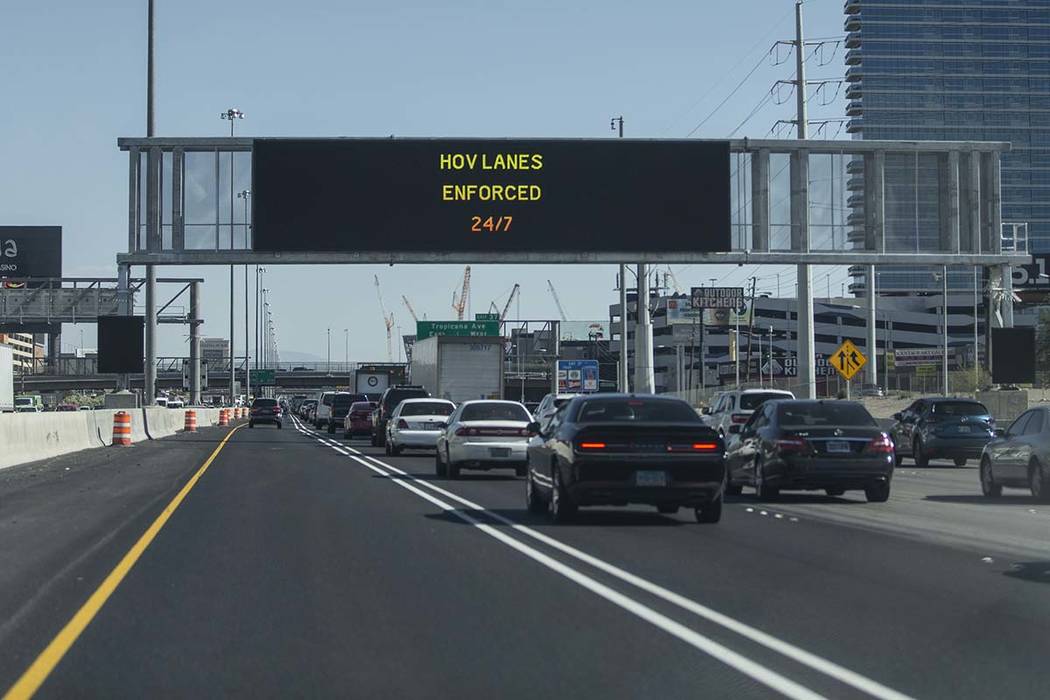Project Neon traffic messaging signs delayed in Las Vegas
Motorists will have to wait a little longer for the dynamic traffic messaging signs on area highways to go live, but if all goes as planned it will be an early Christmas present from the state Department of Transportation.
The 42 Traffic Management signs installed along north and southbound Interstate 15 between Russell Road and Washington Avenue and U.S. Highway 95 between Valley View Boulevard and I-15 won’t go live until December, after originally being pegged to be operational this month. The signs were installed as part of Project Neon, the nearly $1 billion 4-mile widening of I-15 from the Spaghetti Bowl interchange to Sahara Avenue.
The ATM sign activation has taken longer than anticipated, partly due to some unexpected bad fiber network patches as well as the time it takes to learn the system that will operate it, according to Tony Illia, transportation department spokesman.
“This is a sophisticated and complex new technology, necessitating a period of familiarization and education,” Illia said. “Kimley-Horn, for example, has spent the last year writing and coding the custom computer software created specifically for the new signs, ensuring proper communication between signs as well as a comprehensive integration with both the Freeway and Arterial System Transportation facility and Southern Nevada Traffic Command Center.”
For now the signs sit with the message “HOV Lanes Enforced 24/7” sprawled across them, until the lengthy testing phase is complete.
The signs have successfully undergone standalone testing, including testing of the cabinets, closed caption television, field-hardened ethernet switches, flow detectors (or devices that monitor traffic flows in each lane), and ramp meters, before being connected to the fiber network, Illia said.
On Tuesday the signs will undergo subsystem testing for 72 consecutive hours, ahead of a longer test period.
“The signs will be tested remotely through our fiber communication network,” Illia said. “If successful, the signs will then undergo 60 consecutive days of system acceptance testing whereby the signs are tested remotely. This final test determines that the signs are properly communicating with each other as well as through the Freeway and Arterial System Transportation center and Southern Nevada Traffic Center.”
The full-color LED signs, manufactured by Daktronics — known for developing video boards for sports arenas and stadiums — are supported by gantries that measure up to 13-feet-tall by 77-feet-wide, spanning the width of the freeway.
The signs are more sophisticated and dynamic than the existing 20-year-old freeway messaging signs, providing next-generation, real-time driver information about detours, crashes, speed limit changes and lane restrictions.
The signs are said to improve safety and traffic flows by reducing secondary crashes. The signs can alert drivers to lanes that are closed ahead and the digital speed limit signs can change in real time, Illia said.
San Diego installed ATM signs and reduced serious crashes by 46 percent and overall crashes by 20 percent, he noted.
The signs are expected to benefit travel through the resort corridor, specifically aiding visitors unfamiliar with the area, Illia said.
“Southern Nevada last year saw over 42 million visitors with nearly 70 percent driving during their trip,” he said. “As such, the signs are positioned every half-mile along core portions of I-15 and U.S. 95, thereby creating a smart-lane corridor that leverages technology for an optimal traveling experience.”
Mileage report
The Department of Motor Vehicles implemented a law approved by the Legislature this year that requires motorists to submit their odometer readings when they register their vehicles.
Assembly Bill 483 directs the DMV to obtain odometer readings of vehicles at the time of any original vehicle registration, registration renewal or vehicle sale.
Motorcycles and mopeds are exempt, along with certain other vehicles such as farm vehicles.
To streamline the process the DMV will use the odometer readings from emissions tests performed in Clark and Washoe counties.
Owners are required to submit odometer readings on all other cars, trucks, buses and recreational vehicles, of any size or fuel type, including electric vehicles and vehicles in rural areas.
“The DMV’s online services and kiosks will accept odometer readings and we encourage you to continue to use them,” said DMV Director Julie Butler in a statement. “Just remember to write down your odometer reading or take a picture of it before you get started.”
Data from odometer readings will be used to compile reports for the Nevada Legislature on total miles driven to aid in future decisions on funding for roadways. The program could see the state move away from a gas tax to fund roadwork and instead tax drivers based on the miles they drive each year.
This is a pilot project that runs through Dec. 31, 2026.
Send questions and comments to roadwarrior@reviewjournal.com. Please include your phone number. Follow @mickakers on Twitter.


















